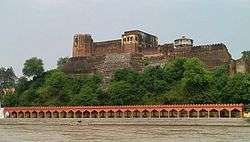Akhnoor Fort
| Akhnoor Fort | |
|---|---|
 | |
| Location | Akhnoor, Jammu and Kashmir, India |
| Coordinates | 32°53′47″N 74°44′27″E / 32.8963°N 74.7407°ECoordinates: 32°53′47″N 74°44′27″E / 32.8963°N 74.7407°E |
| Built | 1657-1672 |
| Architect | Ustad Beg Kashmiri |
| Architectural style(s) | Aurangzeb |
| Type | Cultural |
| State Party |
|
Akhnoor Fort (Hindi: अखनूर किला) is on the right bank of Chenab River (ancient name Asikni). Construction was started by Mian Tej Singh in 1762 AD and completed by his successor Raja Alum Singh in 1802.
The fort has high fortification walls with bastions at regular intervals and is crowned with battlements. There are two-storeyed watch-towers at the corners, which are crowned by battlements and merlons. The fort has two parts which are bifurcated by a wall with a gate leading to the palace on the southern side. The palace is two-storeyed, and the walls facing the courtyard have decorated arches, some of which contain mural paintings.
Access to Akhnoor Fort is obtained through both the river sides and the northern side. Formerly, a large part of the fort was in ruins; conservation work is in progress.
History
The Akhnoor Fort was perched upon an ancient site, locally known as Manda, which has been subjected to a limited excavation, which in turn has exposed a threefold sequence of culture.
- Period I is represented by Harappan red and grey pottery consisting of jars, dish-on-stand beakers and goblets, along with other objects, including copper pins, bone arrowheads, terracotta cakes and sherds with Harappan graffiti.
- Period II is marked by the presence of early historic pottery.
- Period III is represented by Kushana objects and impressive walls of rubble diaper masonry flanked on both sides by a 3-metre-wide street.[1][2]
References
- ↑ http://www.asisrinagar.com/jammu-region.html
- ↑ "{title}". Archived from the original on 16 January 2013. Retrieved 9 May 2013.